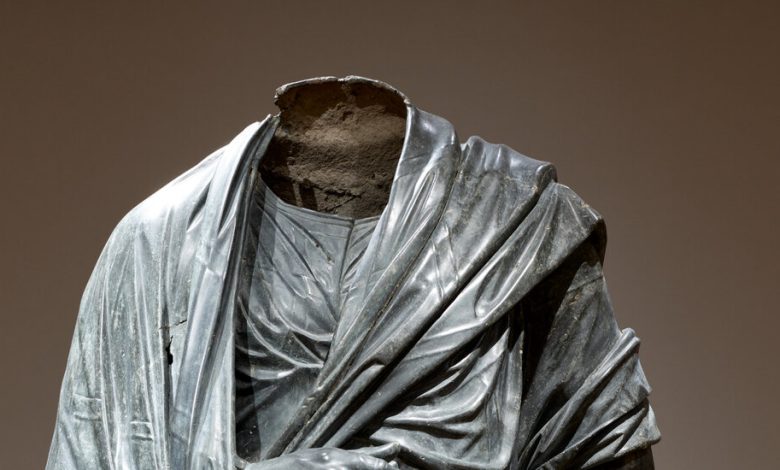Cleveland Museum Sues to Block Seizure of Its ‘Marcus Aurelius’ Bronze

The Cleveland Museum of Art on Thursday filed a court challenge seeking to block a seizure order from New York investigators who assert that one of the museum’s premier statues, a headless bronze valued at $20 million, had been looted from Turkey in the 1960s.
In court papers filed in Federal District Court in Ohio, the museum said that, actually, the evidence presented by the investigators from the Manhattan district attorney’s office had not been compelling. The museum disputed that the larger-than-life statue, which investigators believe depicts the great Roman statesman Marcus Aurelius, was even from Turkey and suggested that it was really the torso of a philosopher, not an emperor.
Describing the investigators’ evidence as “conjecture,” the museum said in its filing: “In this case, the evidence presented by the Defendant has fallen short of persuasive proof that the Philosopher is in fact a piece of stolen property belonging to the Republic of Türkiye.”
The investigators had already persuaded a New York judge to authorize the seizure of the bronze that, with its flowing robes and stoic posture, has held pride of place in the Greek and Roman galleries at the museum in Cleveland since its acquisition in 1986. Turkish investigators have said they also have evidence the statue in Cleveland was looted but officials said the museum had fended off their claims, saying Turkey had provided no hard evidence of theft.
Until recently, the museum’s website had described the statue as “The Emperor as Philosopher, probably Marcus Aurelius (reigned AD 161-180),” adding that the item had originated from “Turkey, Bubon(?) (in Lycia), Roman, late 2nd Century.”
The museum had also written in an accompanying description that the statue “likely represents Marcus Aurelius, the Roman emperor known for his philhellenism and Stoic writings.” Aurelius wrote “Meditations,” a classic work on Stoic philosophy.
But earlier this year, the museum removed the website’s references to Turkey and Aurelius and changed the text to read: “Draped Male Figure, c. 150 BCE-200 CE,” adding, “Roman or possibly Greek Hellenistic.” It also altered the language of its accompanying description to read “without a head, inscription, or other attributes, the identity of the figure represented remains unknown.”
The filing represents a rare challenge by an art organization to a seizure order from the Manhattan district attorney’s office, which in recent years has been responsible for the successful return of several thousand items to countries whose cultural heritage had been subject to looting.
The museum took note of that track record, acknowledging in its filing that the district attorney’s office had been extremely successful in such cases. But it said that in this case the evidence did not match up.
It cited a former Cleveland curator, Arielle P. Kozloff, who it said had questioned in the past whether the statue had come from an ancient site, Bubon, in Turkey. “Based on subsequent research, she now believes that the Philosopher did not come from Bubon and that any previously stated connection between Bubon and the Philosopher was mere conjecture,” the filing said.
It asked the court to declare the museum the rightful owner of the statue.
Investigators responded to the court challenge with a statement that said: “The Manhattan District Attorney’s Office has successfully recovered more than 4,600 illegally trafficked antiquities from numerous individuals and institutions. We are reviewing the museum’s filing in this matter and will respond in court papers.”
The museum’s court challenge was first reported by Cleveland.com. The statue was thought by New York and Turkish investigators to have been part of a shrine built during Roman rule around A.D. 50 to A.D. 250, in what is today southwestern Turkey, to honor a succession of Roman emperors.
Turkish officials have said they have been telling the Cleveland museum that the statue, which is 6 feet 4 inches tall without its head, was stolen in the 1960s during a looting spree at the archaeological site. They have already gotten back several other statues thought to have been from the same location.
In the past year, as part of its investigation into the Turkish looting claims, the district attorney’s Antiquities Trafficking Unit has seized artifacts at the Metropolitan Museum of Art; the Museum of Greek, Etruscan, and Roman Art at Fordham University; and the Worcester Art Museum in Massachusetts.
Turkey’s claim on the statue has hinged in part on persuading investigators that the statue in fact depicts Marcus Aurelius because the stone plinth where they say it had stood is inscribed with that emperor’s name.
The statue had been seized in place at the Cleveland museum under a warrant from New York investigators that was signed by a New York State Supreme Court judge on Aug. 14.
In its filing on Thursday, the museum said that it had bought the statue in 1986 from the Edward H. Merrin Gallery for $1.85 million. The museum provided a bill of sale from the date of its purchase that said it was buying a “Figure of a Draped Emperor (Probably Marcus Aurelius), Roman, late 2nd Century A.D., bronze.”
